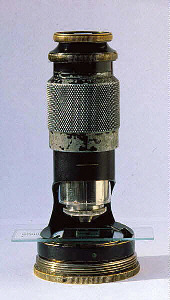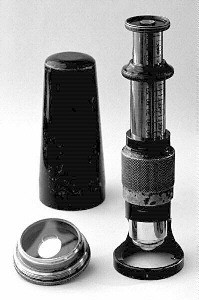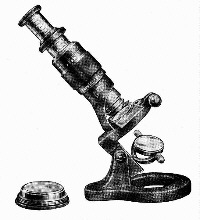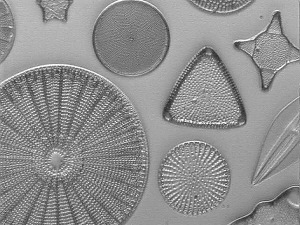There are a number of papers about unusual microscopes in Micscape which are a real pleasure to read for everybody interested in this field. I would like to contribute one more paper to this group, about the historical TAMI pocket microscope.
The Hensoldt company
The German company Hensoldt in Wetzlar, in comparison to some
famous British microscope manufacturers—a rather young
company, was founded by Moritz Carl Hensoldt in 1852. Early
microscope catalogues included many different types of
compound microscopes, oil and water immersion objectives and
several dissecting microscopes. In particular, Hensoldt
binoculars and spotting scopes soon had a worldwide
reputation, though the company never reached the fame of its
big brothers Zeiss and Leitz.
There had always been some parallel production of optical instruments for the German army. For obvious reasons military production decreased drastically after the First World War. As a consequence, the Hensoldt company decided to return to its microscopical tradition. In 1920 a new product line of field microscopes was launched starting with the Tami (i.e. Taschenmikroskop, pocket microscope). In 1928 the Hensoldt share majority was taken over by Zeiss but at least some part of the Hensoldt products were still sold with the Hensoldt trade mark and even today there is still a Hensoldt group within the Zeiss company. The Tami pocket microscope and its successors have been widespreadly used among German microscope amateurs, also after the Second World War.
Features of the Tami microscope
The Tami (see fig. 1 and 2) is an extremely small compound
microscope for incident and transmitted natural light. The
very small concave mirror for transmitted light is sealed in
a flat cylindrical metal base with a glass cover on top of it
(the stage). The mirror base can be rotated to adjust the
illumination and can be removed for investigations with
incident light. Two extractable, straight tubes zoom the
magnification from 35x to a maximum of 225x. Focusing is done
with concentrical tubes linked by a thread. The front lens of
the single objective is removable for low magnifications, the
eyepiece threaded into the tube. A massive brass cover which
can be threaded on the base serves as a transport protection
for the microscope. Fig. 3, an illustration taken from the
Hensoldt catalogue, shows the Tami mounted on the optional
additional support.
For those who are interested in technical details I have compiled some more data in the two tables below.
Table 1: Optical and mechanical features
| Magnification | zoom range from | 35x to 225x |
| Change of magnification | by means of two stage telescopic tubes (and via removal of front lens) | with variable tube length from about 70 mm to 160 mm |
| Magnification reading | markings at the outer side of the tubes | in spacings of 5 |
| Focusing | focusing with thread in concentric tubes | 1 mm per turn |
| Objective | achromatic,
with removable front lens, no inscription non-RMS thread |
magnification
about 15 x with N.A. about 0.30 or better outer diameter of thread 21.5mm |
| Eyepiece | fixed non-standard eyepiece | magnification
ca. 15 x diameter of eyepiece tube: 20 mm |
| Field of view | at
magnification 35 x at magnification 225 x |
ca. 4 mm ca. 0.6 mm |
| Mirror | concave mirror on a small inclined socket in the sealed metal base. The base can be rotated in the base mount around the z-axis in order to adjust illumination | diameter of mirror ca. 1.4 cm |
| Electrical illumination | accessory | |
| Condenser | none | |
| Diaphragm | none | |
| Filter-holder | none | |
| Stage | circular,
on the removable circular mirror base made of a flat
cylindrical metal body with glass cover. Frosted ring as center mark. One removable "U"-shaped iron clip for standard slides |
diameter
of removable base: 3.6 cm diameter of usable stage (including base mount) 4.25 cm diameter of frosted ring: 9 mm |
Table 2: Dimensions, weight, material, inscription and prices
| Dimensions | max. height of microscope stowed away with cover | 10.3 cm |
| max. height of microscope in use (with both tubes extracted) | 19.5 cm | |
| min. height of microscope (with tubes retracted) | 10 cm | |
| max. diameter incl. cover | 4.6 cm | |
| Weight | weight of sealed base with mirror socket and glass stage | 75 g |
| weight of body with tube, optics, base mount and stage clips | 234 g | |
| weight of cover | 137 g | |
| overall weight | 446 g | |
| Materials | base | brass and another copper alloy, probably tin bronze, both covered with black coating, glass cover on top |
| body | copper alloy, probably tin bronze with black coating | |
| tube and objective | nickel-plated brass | |
| focusing tube | aluminium alloy with black coating | |
| cover | brass, black coating | |
| Inscriptions | on top of cover | 7964
(serial no.) HENSOLDT WETZLAR |
| on focusing tube | Hensoldt Wetzlar D.R.P. a. |
|
| on eyepiece | Tami | |
| Prices of Hensoldt microscopes (1933) in German marks | TAMI | 45.-- |
| Electrical illumination | 10.-- | |
| Additional stage (fig. 3) | 10.-- | |
| Top of the line PROTAMI | 230.-- | |
| Simple bench microscope | 103.-- | |
| Top of the line bench microscope | 657.-- |
Performance and usability
The image below (fig. 4) has been taken by means of a cheap
CCD computer camera through the tube of the Tami microscope
at maximum magnification. The eyepiece and the camera
objective have been removed for the photograph in order that
the light could pass through directly from the microscope
objective to the surface of the CCD chip. The largest diatom
on the picture measures about 200 microns in diameter. Please
note that the structures on the smaller, dark diatom on top
of the image are clearly resolved. The light source used was
standard daylight (inside a room at 9 a.m.). Though there is
no condenser, no diaphragm whatsoever and no matte filter you
still get the most important details and a reasonable overall
image quality. And please keep in mind that this microscope
is about 70 years old and just peppermill sized.
The surprisingly even field of view of the Tami doesn't quite reach from left to the right, but is still much better than those formidable 'light at the end of the tunnel' constructions. The frosted ring on the stage is very helpful if you have to find an object on the slide quickly. You even do not have to carry along a slide as you can place the objects or a drop of water directly on the glass stage. So the Tami is ideal if you do not want to carry along a lot of equipment, when you are at the beach or when you just want to screen some samples in order to decide whether it might be worthwhile to take them back at home.
If you are among those people who like to discuss the ergonomics of office furniture and computer screens you will certainly dislike the Tami because of its straight monocular tube, its tiny size, its relatively slow focusing screw and so on ... On the other hand the Tami still today can serve as a really undestructable companion outdoors. The massive rigid metal cover (30% of the overall weight) will perfectly preserve the instrument in many situations which the microscopist probably would not survive. But do we really like this idea?
By the way, the contemporary bigger and much more expensive Hensoldt pocket microscopes METAMI and PROTAMI came with iris diaphragm, adjustable condenser, tripod thread, objective revolver, oil immersion objective (N.A. 1.34), removable double mirror, removable stage and many other thrilling features. But one should not mix this in one paper with the ingenious and still usable simplicity of the Tami microscope.
Comments to the author Martin Mach welcomed.
Images
(photographs by the author).
Click on images to
view larger ones. Use browser back button to return to
article.



